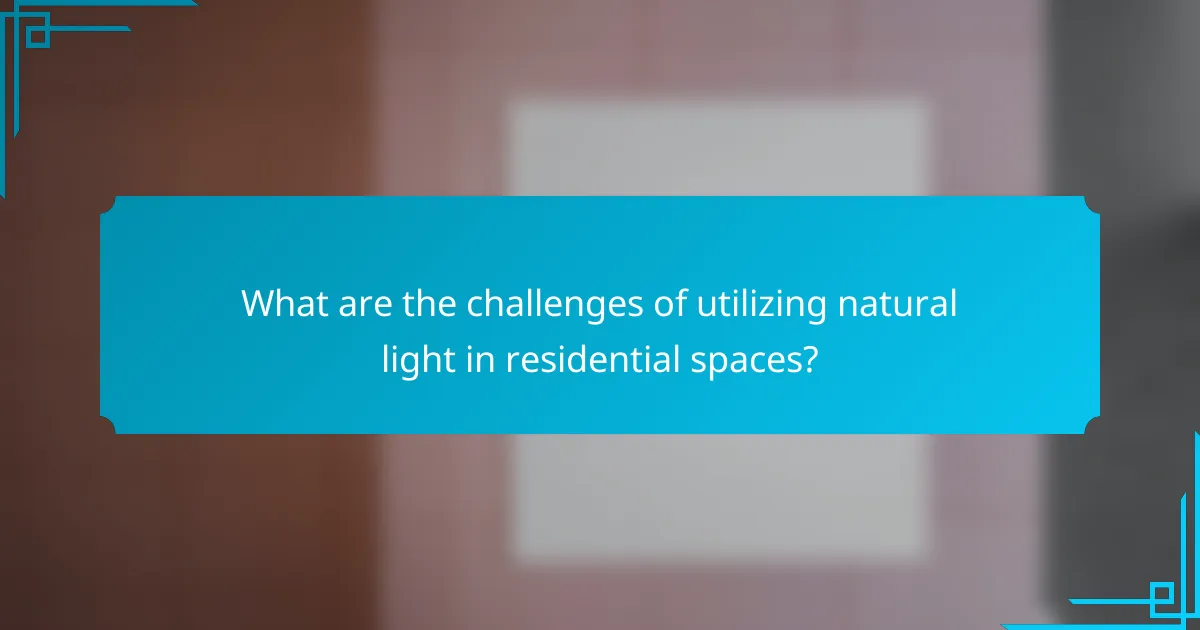Natural light plays a vital role in residential interior design, enhancing both the aesthetic appeal and functionality of living spaces. It contributes to improved mood and well-being, while also increasing productivity and cognitive function. Effective integration of natural light can be achieved through large windows, skylights, and strategic home orientation, which maximizes sunlight exposure. However, challenges such as building orientation, obstructions, and glare must be addressed to optimize natural light. This article explores the significance of natural light in residential design, the techniques for its incorporation, and the potential challenges faced in maximizing its benefits.

What is the Importance of Natural Light in Residential Interior Design?
Natural light is crucial in residential interior design as it enhances the aesthetic appeal and functionality of spaces. It improves mood and well-being by providing a connection to the outdoors. Studies show that natural light can increase productivity and cognitive function. Additionally, it reduces the need for artificial lighting, leading to energy savings. Properly designed windows and openings can maximize light intake. Natural light also highlights architectural features and color schemes. Furthermore, it can create a sense of spaciousness in smaller areas. Overall, incorporating natural light is essential for creating inviting and healthy living environments.
How does natural light influence the overall aesthetic of a space?
Natural light significantly enhances the overall aesthetic of a space. It creates a sense of openness and warmth. Natural light can highlight architectural features and textures. It also affects color perception, making hues appear more vibrant. Spaces flooded with natural light often feel more inviting and comfortable. Studies show that natural light improves mood and productivity. For instance, a study by the Heschong Mahone Group found that daylighting in classrooms boosted student performance. Overall, natural light transforms spaces, making them more visually appealing and functional.
What are the visual effects of natural light on color and texture?
Natural light significantly influences color and texture in interior spaces. It enhances colors by making them appear more vibrant and true to their original hue. This effect occurs due to the full spectrum of natural light, which reveals subtle shades and undertones. For instance, a sunny room can make a blue wall look brighter and more inviting.
Texture is also affected by natural light. It creates shadows and highlights, emphasizing the surface qualities of materials. A textured wall may appear more dynamic when illuminated by sunlight. This interplay can add depth and interest to a room.
Research shows that natural light impacts human perception of color and texture. Studies indicate that daylight can alter the appearance of materials throughout the day. For example, a fabric may look different in the morning light compared to late afternoon.
Overall, natural light plays a crucial role in enhancing both color and texture in residential interior design.
How does natural light impact the perception of space and size?
Natural light enhances the perception of space and size in interiors. It creates a sense of openness and airiness. Bright, natural light can make rooms appear larger than they are. This effect occurs because light reflects off surfaces, reducing shadows. Studies show that well-lit spaces feel more inviting. Natural light also highlights architectural features, drawing the eye upward. This can give the illusion of higher ceilings. Additionally, the quality of natural light changes throughout the day, affecting how we perceive dimensions. A study by the American Society of Interior Designers found that natural light significantly influences spatial perception in residential design.
Why is natural light essential for psychological well-being?
Natural light is essential for psychological well-being because it influences mood and mental health. Exposure to natural light increases the production of serotonin, a neurotransmitter that enhances mood. Studies show that people who receive more natural light report higher levels of happiness and lower levels of depression. Natural light also regulates circadian rhythms, which are crucial for sleep quality. Improved sleep quality contributes to better overall mental health. Furthermore, environments filled with natural light can enhance focus and productivity. Research indicates that workspaces with ample natural light can boost employee satisfaction and performance. Thus, incorporating natural light in residential design positively impacts psychological well-being.
What studies support the benefits of natural light on mental health?
Natural light positively impacts mental health, supported by various studies. One significant study published in the Journal of Affective Disorders found that increased exposure to natural light reduces symptoms of depression. Researchers, including authors from the University of Michigan, highlighted that participants reported improved mood and increased energy levels. Another study in the International Journal of Environmental Research and Public Health noted that natural light exposure correlates with lower anxiety levels. This research involved over 2,000 participants and emphasized the importance of daylight in enhancing overall well-being. Additionally, a study by the University of California found that workplaces with ample natural light lead to higher productivity and better mental health among employees. These studies collectively demonstrate the crucial role of natural light in supporting mental health.
How does exposure to natural light affect mood and productivity?
Exposure to natural light significantly enhances mood and productivity. Natural light increases serotonin levels, which boosts mood and alleviates depression. Studies show that workplaces with ample natural light report higher employee satisfaction. Additionally, natural light can improve focus and concentration. Research indicates that workers in environments with natural light are 15% more productive. This effect is attributed to reduced eye strain and fatigue. Furthermore, exposure to natural light helps regulate circadian rhythms, leading to better sleep and overall well-being. Thus, incorporating natural light into residential design can positively impact mental health and efficiency.
What role does natural light play in energy efficiency?
Natural light significantly enhances energy efficiency in buildings. It reduces the need for artificial lighting during daylight hours. Studies indicate that utilizing natural light can lower energy consumption by up to 30%. Windows designed for optimal daylighting can also improve thermal comfort. Properly placed windows can decrease heating and cooling costs. Natural light positively impacts occupant well-being, leading to increased productivity. This connection between light and efficiency is crucial in residential design. Integrating natural light is a sustainable practice that benefits both the environment and homeowners.
How can natural light reduce reliance on artificial lighting?
Natural light can significantly reduce reliance on artificial lighting in residential spaces. It provides illumination during daytime hours, decreasing the need for electric lights. Studies show that well-designed windows can increase natural light [censured]. This leads to lower energy consumption and reduced electricity bills. Natural light also enhances mood and productivity, making spaces more enjoyable. According to the U.S. Department of Energy, utilizing daylight can cut lighting energy use by 50% or more. Additionally, incorporating skylights and light tubes can further maximize natural light in homes.
What are the cost savings associated with maximizing natural light?
Maximizing natural light can lead to significant cost savings in energy expenses. Increased daylight reduces the need for artificial lighting during daytime hours. This can lower electricity bills by up to 30%, according to the U.S. Department of Energy. Additionally, natural light can improve heating efficiency by warming spaces naturally. This reduces reliance on heating systems, leading to further savings. Studies show that buildings with ample natural light often have lower maintenance costs due to less wear on artificial lighting systems. Overall, maximizing natural light contributes to both immediate and long-term financial benefits for homeowners.

How can natural light be effectively integrated into residential design?
Natural light can be effectively integrated into residential design by utilizing large windows and skylights. These features allow sunlight to penetrate deeper into living spaces. Orientation of the home also plays a crucial role. Positioning windows to face the sun’s path maximizes light exposure throughout the day. Open floor plans can enhance light distribution across rooms. Additionally, using reflective surfaces like mirrors can amplify natural light. Incorporating light wells or atriums brings light into interior spaces. Strategic landscaping can minimize shading from trees and structures. Research indicates that homes with abundant natural light improve mood and productivity.
What architectural features enhance natural light in homes?
Architectural features that enhance natural light in homes include large windows, skylights, and open floor plans. Large windows allow ample sunlight to enter living spaces. Skylights bring light from above, illuminating areas that windows cannot reach. Open floor plans promote light flow between rooms. High ceilings can create a sense of spaciousness and allow more light to penetrate. Light-colored walls and surfaces reflect sunlight, increasing brightness indoors. Glass doors can connect indoor and outdoor spaces, inviting natural light in. These features collectively create a bright and inviting atmosphere in residential interiors.
How do large windows and skylights contribute to light distribution?
Large windows and skylights enhance light distribution in a space. They allow more natural light to enter compared to smaller openings. This increased light improves visibility and reduces reliance on artificial lighting. Large windows provide a wider field of view, creating a more open and airy atmosphere. Skylights, positioned on the roof, capture sunlight from above. This placement helps illuminate areas that might be dark with standard windows. Studies show that spaces with ample natural light can boost mood and productivity. For instance, a study by the Heschong Mahone Group found that natural light can improve learning environments. Overall, large windows and skylights effectively maximize natural light, benefiting residential interiors.
What is the impact of room orientation on natural light availability?
Room orientation significantly affects natural light availability. Rooms facing south generally receive the most sunlight throughout the day. This orientation maximizes exposure to direct sunlight, especially during winter months. Conversely, north-facing rooms receive less direct sunlight, resulting in lower natural light levels. East-facing rooms benefit from morning light, while west-facing rooms capture afternoon sunlight. The angle of sunlight changes with seasons, influencing light intensity and duration. Research indicates that proper orientation can enhance energy efficiency and occupant comfort. A study from the Journal of Building Performance highlights that daylighting strategies can improve well-being and reduce reliance on artificial lighting.
How can interior design elements optimize the use of natural light?
Interior design elements can optimize the use of natural light by strategically placing windows and using reflective surfaces. Large windows allow more sunlight to enter a space, enhancing brightness. Skylights can also be installed to bring light from above, especially in areas where side windows are limited.
Using light-colored walls and ceilings can reflect natural light throughout the room. Mirrors can amplify this effect by bouncing light around the space. Open floor plans facilitate the flow of light between rooms. Additionally, choosing sheer window treatments allows for privacy while still permitting light to filter in.
These design choices create a brighter, more inviting atmosphere, improving both aesthetics and mood. Studies show that natural light can enhance productivity and well-being, making these design strategies beneficial for residential spaces.
What color palettes work best to reflect natural light?
Light-reflective color palettes that work best to enhance natural light include whites, pastels, and light neutrals. These colors help to bounce light around a room, making it feel brighter and more spacious. Soft whites, such as off-white or cream, reflect up to 90% of natural light. Light pastels like soft blues, greens, and pinks also contribute to a bright atmosphere by maintaining a light-reflective quality. Additionally, light grays and beiges can serve as effective neutrals that still reflect substantial amounts of light. Using these color palettes in interior design can create an inviting and airy environment. Research indicates that lighter colors are preferred in spaces where natural light is a priority, as they enhance the overall brightness and visual appeal.
How do mirrors and reflective surfaces enhance natural light?
Mirrors and reflective surfaces enhance natural light by increasing its distribution within a space. They reflect light, allowing it to bounce off walls and ceilings. This reflection amplifies the brightness of a room. Natural light entering through windows can be redirected effectively. Mirrors can create the illusion of larger spaces by visually expanding the area. Reflective surfaces can also add depth and dimension to interior design. Studies show that well-placed mirrors can increase light levels by up to 50%. This makes rooms feel more open and inviting.

What are the challenges of utilizing natural light in residential spaces?
Utilizing natural light in residential spaces presents several challenges. One challenge is the orientation of the building. Homes facing north may receive less direct sunlight compared to those facing south. Another challenge is the presence of obstructions like trees or neighboring buildings. These can block sunlight and reduce its effectiveness. Additionally, window placement is crucial. Poorly positioned windows can lead to uneven light distribution. Glare is another issue that can arise from intense sunlight, making spaces uncomfortable. Energy efficiency can also be affected, as excessive heat from sunlight may require cooling solutions. Lastly, seasonal changes impact natural light availability, varying throughout the year. These challenges necessitate careful planning in residential design.
What obstacles might limit the effectiveness of natural light?
Obstacles that might limit the effectiveness of natural light include obstructions, orientation, and design factors. Obstructions such as buildings, trees, or structures can block sunlight. Poor orientation of a home can lead to reduced sunlight exposure. Design elements like small windows or heavy drapes can also hinder light entry. Additionally, the use of dark colors in interiors can absorb light rather than reflect it. Weather conditions such as clouds or rain can reduce the amount of natural light entering a space. Finally, the geographical location can influence sunlight availability throughout the year.
How do neighboring structures or landscaping affect light access?
Neighboring structures and landscaping significantly impact light access in residential spaces. Tall buildings can cast shadows, reducing sunlight exposure. Dense trees or shrubs may block direct light, affecting room brightness. The orientation of these structures also plays a crucial role. South-facing homes generally receive more light, while north-facing ones may struggle. Studies indicate that proper spacing between buildings enhances light [censured]. For instance, research shows that a distance of at least 1.5 times the height of a neighboring structure can optimize light access. This understanding is essential in residential interior design to ensure adequate natural light.
What solutions exist for homes with limited natural light?
Solutions for homes with limited natural light include using mirrors, light-colored paint, and artificial lighting. Mirrors can reflect light and create the illusion of a brighter space. Light-colored paint enhances brightness by reflecting more light. Artificial lighting, such as LED fixtures, can simulate natural light and brighten dark areas. Skylights and solar tubes can also introduce natural light from above. Window treatments should be chosen carefully; sheer fabrics allow light while maintaining privacy. Additionally, strategically placing indoor plants can enhance the aesthetic while improving air quality. Each solution contributes to a more luminous and inviting environment.
How can homeowners overcome common issues with natural light?
Homeowners can overcome common issues with natural light by using strategic design and decor solutions. Installing larger windows or skylights increases natural light intake. Utilizing mirrors can reflect and amplify light throughout the space. Choosing lighter colors for walls and furnishings enhances the brightness of a room. Employing sheer curtains allows light to filter in while maintaining privacy. Additionally, trimming back outdoor landscaping can prevent obstructions to sunlight. According to the American Society of Interior Designers, well-lit spaces improve mood and productivity. These methods effectively address challenges related to natural light in homes.
What practical tips can be applied to maximize natural light in any room?
To maximize natural light in any room, use reflective surfaces and strategically place mirrors. Reflective surfaces such as glossy paint or glass can bounce light around the space. Position mirrors opposite windows to amplify incoming light. Keep windows clean to ensure maximum light [censured]. Use sheer curtains instead of heavy drapes to allow more sunlight in. Trim outdoor vegetation that may block light from entering the room. Choose light-colored furniture and decor to enhance brightness. Open the space by removing unnecessary furniture that may obstruct light flow. These strategies can significantly increase the amount of natural light in any room.
How can homeowners assess and improve their current lighting situation?
Homeowners can assess their current lighting situation by evaluating the amount and quality of light in each room. They should identify areas that feel dark or poorly lit. Homeowners can also consider the type of light bulbs used and their brightness levels. A common recommendation is to use LED bulbs for energy efficiency and better illumination.
To improve lighting, homeowners should add layers of light. This includes ambient, task, and accent lighting. Installing dimmer switches can provide flexibility in light intensity. Homeowners may also want to rearrange furniture to allow light to flow better.
Incorporating mirrors can reflect light and enhance brightness in a space. Additionally, homeowners should consider window treatments that maximize natural light. Research shows that natural light improves mood and productivity, making it essential in interior design.
The main entity of this article is natural light in residential interior design. The article emphasizes the significance of natural light in enhancing aesthetic appeal, functionality, and psychological well-being within living spaces. Key topics include the impact of natural light on mood, productivity, energy efficiency, and spatial perception, as well as practical strategies for integrating natural light into home design. Additionally, the article addresses challenges related to natural light and offers solutions for maximizing its benefits in residential environments.